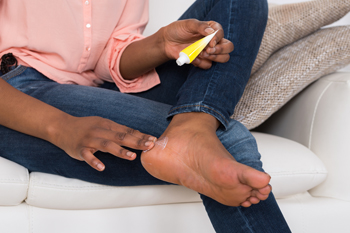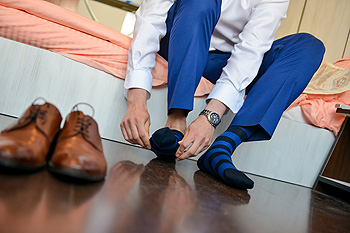 A large percentage of patients who have rheumatoid arthritis notice evidence of this condition in the feet. Some of the symptoms affecting these patients can include soreness, joint instability, and pain which often accompanies the foot as it changes shape. The smaller joints in the foot are typically affected more often than the ankle joint. Daily activities can be difficult to accomplish, and this is often a result of painful foot function. Additional conditions people with rheumatoid arthritis may experience can be poor circulation which causes the feet to have a tingling or numbing sensation. Vasculitis occurs if the blood vessels become inflamed, and may be associated with rheumatoid arthritis. If you have this painful condition, it is suggested that you schedule a consultation with a podiatrist who can properly diagnosis and treat this ailment.
A large percentage of patients who have rheumatoid arthritis notice evidence of this condition in the feet. Some of the symptoms affecting these patients can include soreness, joint instability, and pain which often accompanies the foot as it changes shape. The smaller joints in the foot are typically affected more often than the ankle joint. Daily activities can be difficult to accomplish, and this is often a result of painful foot function. Additional conditions people with rheumatoid arthritis may experience can be poor circulation which causes the feet to have a tingling or numbing sensation. Vasculitis occurs if the blood vessels become inflamed, and may be associated with rheumatoid arthritis. If you have this painful condition, it is suggested that you schedule a consultation with a podiatrist who can properly diagnosis and treat this ailment.
Because RA affects more than just your joints, including the joints in your feet and ankles, it is important to seek early diagnosis from your podiatrist if you feel like the pain in your feet might be caused by RA. For more information, contact Dr. Richard DiMario of Maine. Our doctor will assist you with all of your podiatric concerns.
What Is Rheumatoid Arthritis?
Rheumatoid Arthritis (RA) is an autoimmune disorder in which the body’s own immune system attacks the membranes surrounding the joints. Inflammation of the lining and eventually the destruction of the joint’s cartilage and bone occur, causing severe pain and immobility.
Rheumatoid Arthritis of the Feet
Although RA usually attacks multiple bones and joints throughout the entire body, almost 90 percent of cases result in pain in the foot or ankle area.
Symptoms
Diagnosis
Quick diagnosis of RA in the feet is important so that the podiatrist can treat the area effectively. Your doctor will ask you about your medical history, occupation, and lifestyle to determine the origin of the condition. Rheumatoid Factor tests help to determine if someone is affected by the disease.
If you have any questions please feel free to contact our office located in York, ME . We offer the newest diagnostic and treatment technologies for all your foot and ankle needs.
 Many patients suffer from a condition that is known as cracked heels. It is the name given to dry skin that develops on the heel of the foot, and cracks or fissures will often form that causes pain and discomfort. This condition can gradually develop from standing for extended periods of time for the majority of the day, or from wearing shoes that have an open back. Additionally, research has indicated that obesity plays a significant role in the formation of cracked heels. This is often a result of the added weight the heels must endure. Existing medical conditions such as diabetes and thyroid disorders may contribute to this condition, which causes dry skin that often accompanies these ailments. Mild relief is found when applying a moisturizer to the affected area. In severe cases where bleeding and the possibility of an infection exists, it is suggested to consult with a podiatrist who can properly treat cracked heels.
Many patients suffer from a condition that is known as cracked heels. It is the name given to dry skin that develops on the heel of the foot, and cracks or fissures will often form that causes pain and discomfort. This condition can gradually develop from standing for extended periods of time for the majority of the day, or from wearing shoes that have an open back. Additionally, research has indicated that obesity plays a significant role in the formation of cracked heels. This is often a result of the added weight the heels must endure. Existing medical conditions such as diabetes and thyroid disorders may contribute to this condition, which causes dry skin that often accompanies these ailments. Mild relief is found when applying a moisturizer to the affected area. In severe cases where bleeding and the possibility of an infection exists, it is suggested to consult with a podiatrist who can properly treat cracked heels.
Cracked heels are unsightly and can cause further damage to your shoes and feet. If you have any concerns, contact Dr. Richard DiMario from Maine. Our doctor can provide the care you need to keep you pain-free and on your feet.
Cracked Heels
Cracked heels appear unappealing and can make it harder for you walk around in sandals. Aside from looking unpleasant, cracked heels can also tear stockings, socks, and wear out your shoes. There are several methods to help restore a cracked heel and prevent further damage.
How Do You Get Them?
Dry skin is the number one culprit in creating cracked heels. Many athletes, walkers, joggers, and even swimmers suffer from cracked heels. Age and skin oil production play a role to getting cracked heels as well.
Promote Healing
Over the counter medicines can help, especially for those that need instant relief or who suffer from chronic dry feet.
Wear Socks – Wearing socks with medicated creams helps lock in moisture.
Moisturizers – Applying both day and night will help alleviate dryness which causes cracking.
Pumice Stones – These exfoliate and remove dead skin, which allows for smoother moisturizer application and better absorption into the skin.
Change in Diet
Eating healthy with a well-balanced diet will give the skin a fresh and radiant look. Your body responds to the kinds of food you ingest. Omega-3 fatty acids and zinc supplements can also revitalize skin tissue.
Most importantly, seek professional help if unsure how to proceed in treating cracked heels. A podiatrist will help you with any questions or information needed.
If you have any questions, please feel free to contact our office located in York, ME . We offer the newest diagnostic and treatment technologies for all your foot care needs.
 There are many people who enjoy wearing high heels. This type of shoe can enhance the appearance of the legs by making them look longer and thinner. Potential damage to the foot may be diminished if proper stretching exercises are frequently performed, thereby strengthening the foot. Many people may experience heel pain, and this may be a result of shortened calf muscles. There are many foot conditions that can gradually develop from wearing high heels. These may include ingrown toenails, bunions, or Morton’s neuroma, which is a form of nerve damage that occurs between the toes. If you would like additional information about how high heels can affect the feet, consulting with a podiatrist is recommended.
There are many people who enjoy wearing high heels. This type of shoe can enhance the appearance of the legs by making them look longer and thinner. Potential damage to the foot may be diminished if proper stretching exercises are frequently performed, thereby strengthening the foot. Many people may experience heel pain, and this may be a result of shortened calf muscles. There are many foot conditions that can gradually develop from wearing high heels. These may include ingrown toenails, bunions, or Morton’s neuroma, which is a form of nerve damage that occurs between the toes. If you would like additional information about how high heels can affect the feet, consulting with a podiatrist is recommended.
High heels have a history of causing foot and ankle problems. If you have any concerns about your feet or ankles, contact Dr. Richard DiMario from Maine. Our doctor can provide the care you need to keep you pain-free and on your feet.
Effects of High Heels on the Feet
High heels are popular shoes among women because of their many styles and societal appeal. Despite this, high heels can still cause many health problems if worn too frequently.
Which Parts of My Body Will Be Affected by High Heels?
What Kinds of Foot Problems Can Develop from Wearing High Heels?
How Can I Still Wear High Heels and Maintain Foot Health?
If you want to wear high heeled shoes, make sure that you are not wearing them every day, as this will help prevent long term physical problems. Try wearing thicker heels as opposed to stilettos to distribute weight more evenly across the feet. Always make sure you are wearing the proper shoes for the right occasion, such as sneakers for exercising. If you walk to work, try carrying your heels with you and changing into them once you arrive at work. Adding inserts to your heels can help cushion your feet and absorb shock. Full foot inserts or metatarsal pads are available.
If you have any questions please feel free to contact our office located in York, ME . We offer the newest diagnostic and treatment technologies for all your foot and ankle needs.
 There are many professions that require standing for hours, which unfortunately can put a heavy strain on the feet. Oftentimes, people who work on their feet begin to notice aches and pains associated with the stress their feet are under. Examples of common problems that arise from working on your feet are plantar fasciitis, bunions, Achilles tendonitis, swollen feet, and soreness. There are a few simple ways to reduce the risk of developing any of these issues. Wearing comfortable and supportive shoes is the most important step in keeping your feet healthy. Custom made orthotics could also be beneficial. Orthotics made for those who stand for long periods of time could help improve posture, relieve joint pain, and help alleviate other symptoms. Changing positions is also beneficial, because it helps shift the weight being put on the feet. If possible, walking around, standing in different positions, and stretching are easy ways to change position. If you would like more information on how to care for your feet, speak with your podiatrist.
There are many professions that require standing for hours, which unfortunately can put a heavy strain on the feet. Oftentimes, people who work on their feet begin to notice aches and pains associated with the stress their feet are under. Examples of common problems that arise from working on your feet are plantar fasciitis, bunions, Achilles tendonitis, swollen feet, and soreness. There are a few simple ways to reduce the risk of developing any of these issues. Wearing comfortable and supportive shoes is the most important step in keeping your feet healthy. Custom made orthotics could also be beneficial. Orthotics made for those who stand for long periods of time could help improve posture, relieve joint pain, and help alleviate other symptoms. Changing positions is also beneficial, because it helps shift the weight being put on the feet. If possible, walking around, standing in different positions, and stretching are easy ways to change position. If you would like more information on how to care for your feet, speak with your podiatrist.
While working on the feet, it is important to take the proper care of them. For more information about working on your feet, contact Dr. Richard DiMario from Maine. Our doctor will treat your foot and ankle needs.
Working on Your Feet
Standing on your feet for long periods of time can cause stress and pain in your feet. Your whole body may experience change in terms of posture, back pain, bunions, callouses and or plantar warts. There are ways to avoid these conditions with proper foot care, smart choices and correct posture.
Positive Changes
Negative heeled shoe – Choosing this shoe type places the heel slightly lower than the ball of the foot. These are great for overall foot health. Find shoes that fit you correctly.
Go barefoot – Our feet were not designed to be enclosed for all hours of the day. Try to periodically expose your feet to air.
Eliminate Pain
Foot Exercises – Performing simple exercises, incorporating yoga and doing stretches are beneficial. This will allow increased blood flow to the area and muscles of the foot.
Achilles tendon – Stretching the foot out flat on the floor will relax the calf muscles and tendon. These exercises can be performed almost anywhere. Make sure you add these exercises to your daily regimen.
With a little bit of this information and knowing more about foot health, you will notice changes. Foot stretches and proper footwear will help with pain and prevent further issues.
If you have any questions please feel free to contact our office located in York, ME . We offer the newest diagnostic and treatment technologies for all your foot and ankle needs.
 If you notice your middle toes are bent in a downward position, you may have what is referred to as hammertoe. The second toe is typically affected, and it may resemble a hammer as a result of the way it is bent. The most common reasons for hammertoes to develop may be from wearing footwear that does not fit correctly. These may include shoes which do not have ample room for the toes to move freely in. Additional reasons why this condition may develop may be genetic factors, or existing medical conditions which may include bunions or arthritis. Many people experience common symptoms when hammertoe has developed. These may include toe pain when the toes are stretched downward, toes that are curled, or thickened skin on the affected toe and surrounding areas. Hammertoes may be prevented by wearing shoes that fit correctly, and this often means choosing shoes that have adequate room for the toes to move about in. If you have this ailment, please consult with a podiatrist who can discuss proper treatment options with you.
If you notice your middle toes are bent in a downward position, you may have what is referred to as hammertoe. The second toe is typically affected, and it may resemble a hammer as a result of the way it is bent. The most common reasons for hammertoes to develop may be from wearing footwear that does not fit correctly. These may include shoes which do not have ample room for the toes to move freely in. Additional reasons why this condition may develop may be genetic factors, or existing medical conditions which may include bunions or arthritis. Many people experience common symptoms when hammertoe has developed. These may include toe pain when the toes are stretched downward, toes that are curled, or thickened skin on the affected toe and surrounding areas. Hammertoes may be prevented by wearing shoes that fit correctly, and this often means choosing shoes that have adequate room for the toes to move about in. If you have this ailment, please consult with a podiatrist who can discuss proper treatment options with you.
Hammertoes can be a painful condition to live with. For more information, contact Dr. Richard DiMario of Maine. Our doctor will answer any of your foot- and ankle-related questions.
Hammertoe
Hammertoe is a foot deformity that occurs due to an imbalance in the muscles, tendons, or ligaments that normally hold the toe straight. It can be caused by the type of shoes you wear, your foot structure, trauma, and certain disease processes.
Symptoms
Risk Factors
Treatment
If you have hammertoe, you should change into a more comfortable shoe that provides enough room for your toes. Exercises such as picking up marbles may strengthen and stretch your toe muscles. Nevertheless, it is important to seek assistance from a podiatrist in order to determine the severity of your hammertoe and see which treatment option will work best for you.
If you have any questions, please feel free to contact our office located in York, ME . We offer the newest diagnostic and treatment technologies for all your foot care needs.